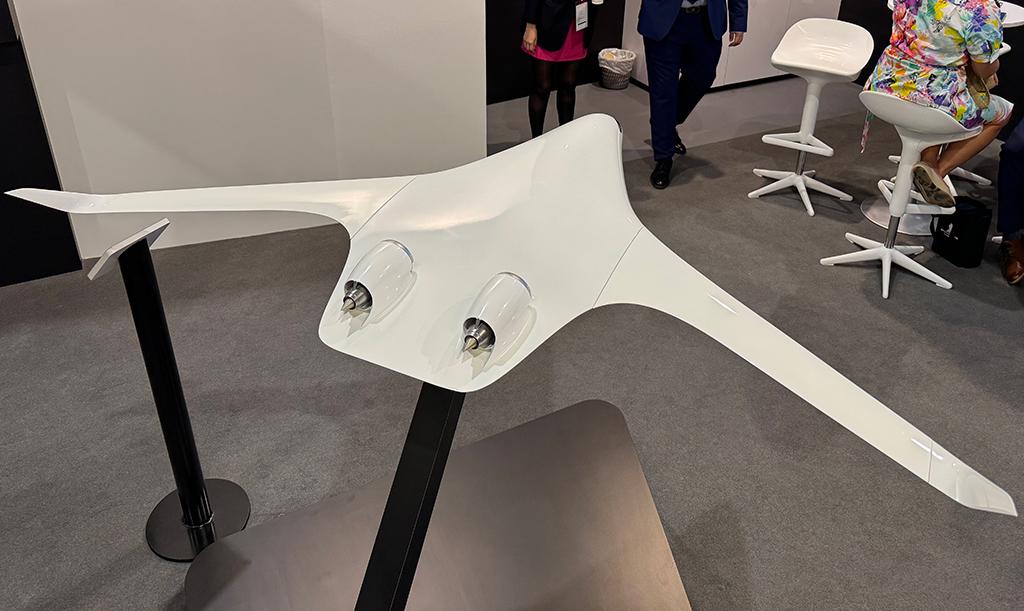
JetZero's blended wing body demonstrator, displayed here at the Singapore Airshow, will pave the way for the full-scale aircraft being developed as part of a DIU contract awarded in 2023.
SINGAPORE—California-based JetZero says it is poised to begin flight tests of a subscale version of its full-scale blended wing body (BWB) multirole commercial and military demonstrator in the next few weeks.
“It should be in a matter of days and weeks,” JetZero CEO Tom O’Leary tells Aviation Week.
“We’re ready and we are just waiting for a dry lakebed,” he adds, referring to the expansive areas of Edwards AFB, California, that will be used for takeoff and landing tests. A large portion of the lakebed remains inundated with water following heavy rains in Southern California.
The 23-ft.-wingspan, 12.5%-scale vehicle was funded under a 2021 contract awarded during an earlier round of NASA’s Sustainable Flight Demonstrator program and will be used mainly to evaluate the novel articulating nose leg design—a key feature of the JetZero BWB concept. The vehicle will pave the way for the full-scale aircraft, which is being developed under an initial $235 million U.S. Defense Innovation Unit (DIU) contract awarded in 2023.
First designed by JetZero co-founder and Chief Technology Officer Mark Page—a BWB veteran who helped create the original McDonnell Douglas blended wing concept in the 1990s—the configuration moves the nose landing gear forward and the main gear rearward into unused internal volume aft of the cabin. For takeoff, the nose gear extends by several feet to increase angle of attack by about 6 deg., allowing the BWB’s body to produce lift.
The initial flight-test phase is expected to last around three months, though the subscale vehicle will likely continue to be used for additional testing as the program continues, Page says. Flight tests of the small demonstrator were originally expected to start late in 2023 but were delayed by late delivery of some flight control system components, O’Leary adds.
JetZero’s four-year development plan is due to culminate in flight tests of the demonstrator beginning in the first quarter of 2027. Sized around the capacity of a Boeing 767, with a wingspan close to that of an Airbus A330, the demonstrator will be built and tested in collaboration with Northrop Grumman and its prototyping subsidiary Scaled Composites.
“We’re completely on track with the timing for the demonstrator,” O’Leary says. “We just cleared our systems requirements review in January and are going through defined entrance and exit criteria with the Air Force and representatives from NASA, Northrop Grumman and Scaled Composites,” Preliminary design review is scheduled for June, while the critical design review is set for the first half of 2025.
As part of planning for the commercial variant of the BWB, which is targeted at what JetZero says is the underserved midmarket sector, the company is hosting around a dozen major airlines at a symposium in Long Beach, California. “It’s a sort of preworking group, and actually we would like their input on what they would like out of a working group,” O’Leary says. “We want to sit down and say: ‘Okay, let’s talk about what a working group should be.’ That’s the main thing.”
Commenting on concerns about marginal engine power believed to have been expressed recently by the U.S. Air Force over JetZero’s selection of the Pratt & Whitney PW1100G for the demonstrator, O’Leary says: “It’s always been part of our thesis that we’d be pushing up toward the limit of a single-aisle engine and make a midmarket airplane.
“The main thing is really what does the Air Force want to see out of it? And more thrust would obviously be better if you’re carrying fuel around,” O’Leary says. “So, we’re not we’re not pulling the wool over anybody’s eyes on that front.
“It would be awesome to have a new engine, but we’re not a member of the (Airbus-Boeing) duopoly,” he adds. “We cannot go to the engine companies and say: ‘You will now build us a new engine.’ The Air Force program is a commercial demonstration program—it’s not a tanker, it’s not a transport demonstrator program. They’re investing in our program because they think the taxpayer will benefit as an investor.”






Comments
This would work for any civil version, any US military use would come under NIH!